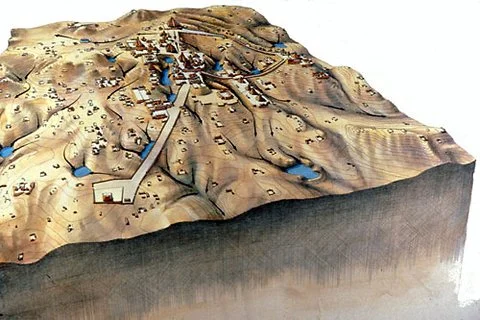
Maya Civilization
Unlike the river-fed cities of Mesopotamia, most Maya cities in the southern lowlands were built in karst landscapes with no rivers or lakes nearby. Despite this, they supported dense populations and monumental architecture for centuries. Their solution was engineering: the Maya constructed massive reservoirs, artificial terraces, and aqueducts to capture and store rainwater. But this wasn’t just functional. Water was sacred, and controlling it meant controlling access to the divine.
Excavations at sites like Tikal, Caracol, and Calakmul have revealed vast, plaster-lined reservoirs capable of storing water through the dry season. These were not small community wells, they were city-wide systems, carefully engineered and ritualized. According to archaeologist Lisa Lucero, reservoirs were often built near royal palaces and temples, turning access to water into a display of power. Kings didn’t just manage water; they embodied its control [3].
In times of drought, rulers performed ceremonies to summon rain gods like Chaac. These events reinforced their spiritual legitimacy and reassured the population that divine forces still supported the dynasty. Control over reservoirs, and over the rituals associated with them, became a means of maintaining loyalty and order.
The sacred Maya text Popol Vuh places water at the heart of creation and destruction. In the opening scenes, the world is submerged in a “great calm,” a watery void from which life must be shaped.
“All alone is the sky and the sea. Nothing stirs: no people, no animals, no birds, no fish, no crabs, no trees, no stones, no caves, no canyons… only the sky exists, the face of the earth is not clear.”
— Popol Vuh, trans. Christenson [4].
This watery chaos is not neutral, it is a sacred force that must be ordered. Later, when humans displease the gods, floods and storms return as punishment. By referencing these cosmic cycles, Maya rulers linked their role in managing water on Earth with the divine role of maintaining cosmic balance.
Maya stelae and glyphs further confirm that water was more than a commodity, it was a symbol of order. In The Memory of Bones, Houston, Stuart, and Taube describe glyphs that link kingship to water control, especially through dedicatory inscriptions at reservoirs and ritual basins. Some texts associate rulers with the imagery of “water mountains,” sacred places where earth and sky meet through flowing water [5].
These symbols tied earthly leadership to celestial cycles and reinforced elite identity. In short, Maya infrastructure wasn’t just technological, it was theological.
The Maya show us that water systems in ancient civilizations could be both elegant and symbolic. By controlling water physically and spiritually, Maya elites constructed a form of rulership where hydrology and cosmology merged. They built not only reservoirs, but legitimacy, collecting both rainfall and reverence in stone-lined basins beneath the temples.